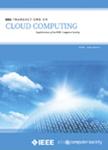版权所有:内蒙古大学图书馆 技术提供:维普资讯• 智图
内蒙古自治区呼和浩特市赛罕区大学西街235号 邮编: 010021

作者机构:PLA Informat Engn Univ Zhengzhou 450000 Henan Peoples R China
出 版 物:《IEEE TRANSACTIONS ON CLOUD COMPUTING》 (IEEE Trans. Cloud Comput.)
年 卷 期:2022年第10卷第3期
页 面:1634-1646页
核心收录:
学科分类:0808[工学-电气工程] 08[工学] 0835[工学-软件工程] 0812[工学-计算机科学与技术(可授工学、理学学位)]
基 金:Natural National Key Basic Research Program of China [2016YFB050190104] National Natural Science Foundation of China [61802436, 61702550]
主 题:Cloud computing intrusion detection system (IDS) feature extraction deep learning contractive auto-encoder support vector machine
摘 要:Security issues have resulted in severe damage to the cloud computing environment, adversely affecting the healthy and sustainable development of cloud computing. Intrusion detection is one of the technologies for protecting the cloud computing environment from malicious attacks. However, network traffic in the cloud computing environment is characterized by large scale, high dimensionality, and high redundancy, these characteristics pose serious challenges to the development of cloud intrusion detection systems. Deep learning technology has shown considerable potential for intrusion detection. Therefore, this study aims to use deep learning to extract essential feature representations automatically and realize high detection performance efficiently. An effective stacked contractive autoencoder (SCAE) method is presented for unsupervised feature extraction. By using the SCAE method, better and robust low-dimensional features can be automatically learned from raw network traffic. A novel cloud intrusion detection system is designed on the basis of the SCAE and support vector machine (SVM) classification algorithm. The SCAE+SVM approach combines both deep and shallow learning techniques, and it fully exploits their advantages to significantly reduce the analytical overhead. Experiments show that the proposed SCAE+SVM method achieves higher detection performance compared to three other state-of-the-art methods on two well-known intrusion detection evaluation datasets, namely KDD Cup 99 and NSL-KDD.